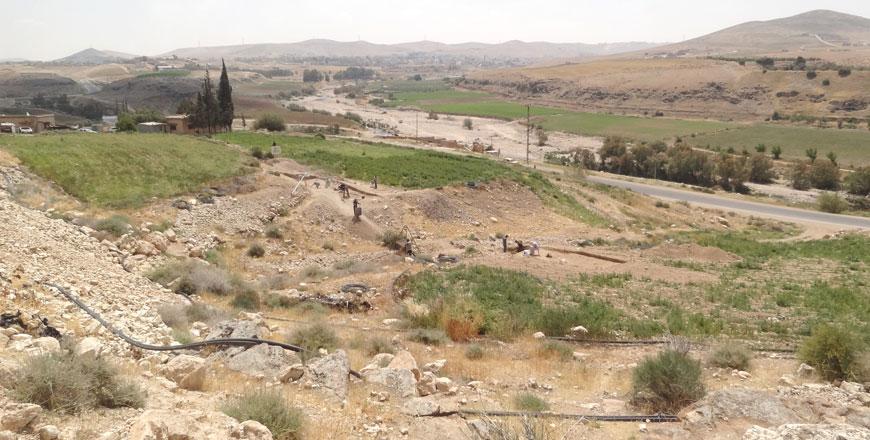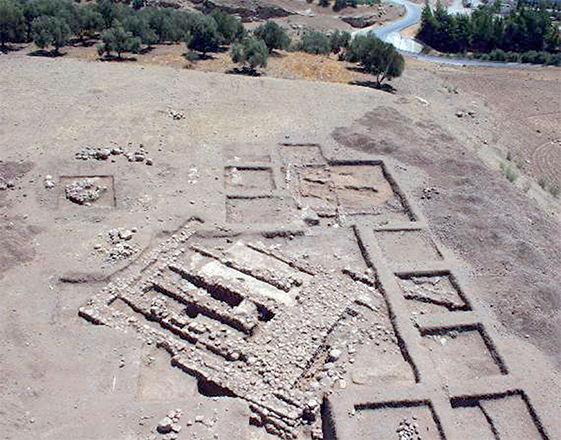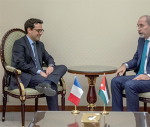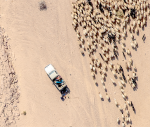You are here
Pottery sherds studies: Focusing on early human occupation of Jordanian wadis
By Saeb Rawashdeh - Apr 17,2024 - Last updated at Apr 17,2024

Plaster human statues and busts found at Ain Ghazal, a site located in northeastern Amman (Photo courtesy of ACOR)
AMMAN — Evidence of human occupation in wadis from the Jordanian central massive goes back to the Palaeolithic period as it was evidenced in the Wadi Zerqa / Duleil confluence. The archaeological teams combined palaeozoological, palaeo-botanical, geological and palaeo-environmental methodology.
The published information concerned with the hunters and gatherers in central Jordan is based on stone tools found either during surveys or excavations, and on the fossilised animal bones.
"So far, no hominid remains dated to the Palaeolithic period have been encountered in Jordan. However, we present below a brief study of the prehistoric settlements development of the fringes of the arid areas in central Jordan starting from the Palaeolithic up to the end of the Chalcolithic period," said the scholar Zeidan Kafafi, from the Yarmouk University in Irbid.
“During the 6th millennium BC, the inhabitants of Jordan started to manufacture pottery vessels for their daily use”, Kafafi continued, and this period lasted from ca. 5500 – 4500 BC. Some Pre-Pottery Neolithic sites such as Beidha in Southern Jordan were completely abandoned at the end of the 7th millennium, while their sites, like Jericho and Munhata on the west side of the Jordan Valley were re-inhabited after an interruption which seems to have lasted for almost a millennium.
Some scholars have interpreted the gap with the climate change, although it is not completely confirmed.
"The excavators of the LPPNB and Late Neolithic sites in Jordan have noticed a gravelly layer separating Pre-Pottery and Late Neolithic contexts. It may be argued that only a natural factor could have caused this widespread presence of this gravelly layer at several PPN and LN sites in Jordan,"Kafafi continued, adding that the environmental setting of the Southern Levant is very different from that of the Northern Levant.
The cultural development in eastern Badia (i. e. the Black Desert) varies from that of the Jordan Valley and the Mediterranean zone and human groups had to adapt their way of life to these different climate environments.
It might very well be for example that pastoralism was introduced by some groups, whereas others went on with the settled life of farming communities, the professor continued, adding that several Pottery Neolithic cultures and sites belonging to the 6th and 5th millennia BC have been identified in Jordan in general and Wadi az-Zarqa in particular.
"Archaeological excavation conducted in the eastern part of the Jordan Valley area showed that the Pottery Neolithic villages were established during the second half of the 6th millennium, such as Abu Hamid and Teleilat el-Ghassul, but more sites related to the 5th millennium BC, such as Tell esh-Shuneh North and Pella, have been found," Kafafi underlined, noting that the mountain ranges were densely occupied during the 6th and 5th millennia BC.
Furthermore, many farming villages (e. g. ʿAin Rahub, Abu Thawwab, and Wadi Shuʿeib) and farmsteads (e. g. Wadi Ziglab 200, ʿAin el-Buma) have been excavated in the recent time and archaeological excavations conducted by Andrew Garrard and Alison Betts in the desert area indicate that the inhabitants of the early 6th millennium BC lived in seasonal hunting camps, called “Burin sites”.
"These sites differ in size ranging between 4500 metres square at Jilat 2369 and 240 metres square at Dhuweila. It has been recognised that the desert dwellers built large stone circles of upright slabs measuring ca. 18 m in diameter at Jilat," he said, adding that to elaborate more on the fringes of the arid zones in Central Jordan during the Pottery Neolithic period, the results of the recent excavations at ʿAin Ghazal and eh-Sayyeh 71 in the Wadi az-Zarqa proved that the inhabitants of this region during the 6th and 5th millennia BC were either farmers such as at ʿAin Ghazal, or probably semi-nomads as at eh-Sayyeh.
The research conducted at Wisad Pools by Gary Rollefson and his team evidenced that the pastoralists of the PN living in the desert were in contact with those in the fringes of the arid regions, Kafafi explained.
"This is due to the fact that Yarmoukian pottery sherds parallel to those found at other Yarmoukian sites, e. g. at eh-Sayyeh were encountered at Wisad. In addition, the excavators of Wisad Pools argue that the lifestyle at the site during the Pottery Neolithic parallels to mobile hunter-pastoralists from other parts of the Southern Levant, but there are some substantial differences such as architecture," Kafafi noted.
Related Articles
AMMAN — The abundance of water in Wadi Al Zarqa enabled the region around archaeological site of eh-Sayyeh to establish a “very attractive”
AMMAN — Located some 500 metres from the old Amman-Jerash road, Tell Abu Suwwan represents one of the Neolithic mega sites whose occupation
AMMAN — Community archaeology, which seeks to empower and involve local communities in the protection and preservation of their shared past,

















